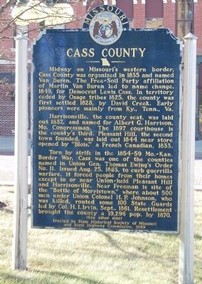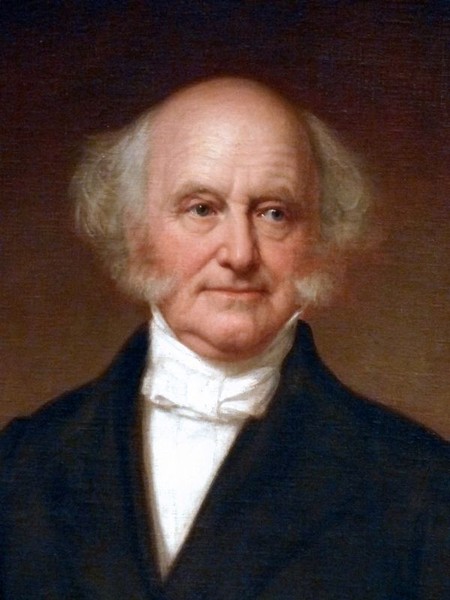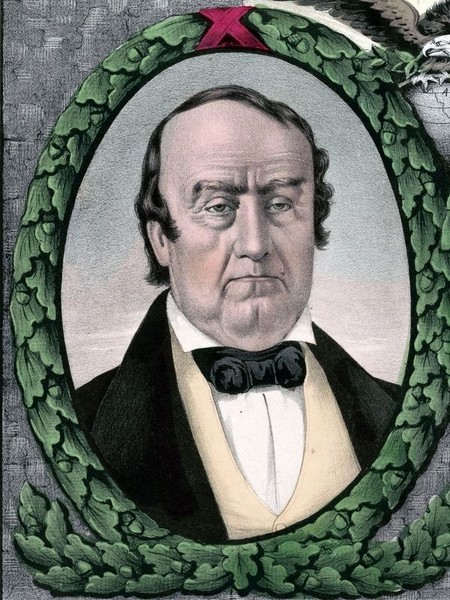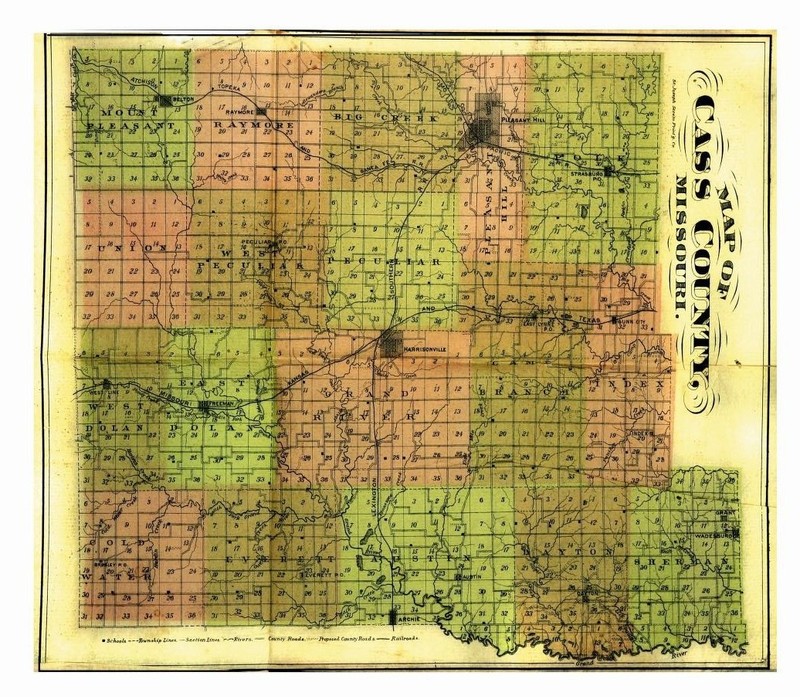Cass County Historical Marker
Introduction
Author-Uploaded Audio
Jennifer Reed, Executive Director of the Cass County Historical Society in Harrisonville, introduces herself and briefly explains what her role is in preserving the county's history.
Text-to-speech Audio
This historical marker located in Harrisonville at the Cass County Courthouse commemorates the founding of Cass County, which was first settled by David Creek in 1825 after the land was ceded from Osage tribes. Cass County is made up of several prominent towns that include Harrisonville, Pleasant Hill, and Gunn City. The land was originally inhabited by the DHEGILA Indians subgroup which are of the Siouan linguistic stock and is made up of the Osage, Quapaw, Omaha, Ponca, and Kansa tribes. There is no evidence that the Kansa tribe had a permanent settlement in the Cass County region, but they occupied the land extending from the Kansas-Missouri River junction to the northern edge of Bates County. In 1818 a land grant was made to some of the Delaware tribe in the region but it was later re-ceded by them in 1825, after which some moved to reservations in Kansas or to Texas. Those who stayed in the region were relatives of the Sauk, Fox, or Kickapoo tribes. The first white settler in Harrisonville was James Lackey who arrived in 1830 and built a cabin on land that was meant for the county seat, making him a squatter. The County was implicated in the Border Wars between Western Missouri and Kansas, it was affected by Order No. 11 which was issued during the Civil War, and saw the violence of the Gunn City Massacre.
Images
Cass County Historical Marker

Martin Van Buren

Lewis Cass

Map of Cass County

Backstory and Context
Author-Uploaded Audio
Jennifer Reed provides background on Cass County's history.
Text-to-speech Audio
Cass County was first organized in 1835 and was originally called Van Buren county for Martin Van Buren. The name was later changed because of Van Buren's "free soil" beliefs, meaning he opposed the expansion of slavery into western territories. The name was changed to Cass after Lewis Cass, who was a democrat. In 1837, Harrisonville was laid out and became the county seat. It was named after the Missouri congressman Albert G. Harrison, although many wanted it to be called Democrat. Pleasant Hill was the second town founded and was laid out in 1844 near a store opened by Blois who was a French Canadian that came to the region in 1833. One of the first buildings in Harrisonville was the First Church two miles southwest of New Hope Baptist (AKA Hopewell). The first house was built by Jason L. Dickey in 1836. The first jail in Harrisonville was the second jail in the entire county and was built in 1838.
Harrisonville was served by the Missouri Pacific and Frsico railroad lines whose construction caused the Gunn City Massacre. In 1857, Cass County approved of $100,000 worth of bonds to be issued at $500 each for the Missouri Pacific Railroad. Before the outbreak of the Civil War, only three bonds had been issued at a total of $1,500. During the war, the bonds were discovered by Federal Colonel Andrew Nugent who assumed they belonged to the railroad and sent them to Leavenworth, Kansas. The legality of the bonds was brought into question following the war and the railroad returned them with fourteen years of accrued interest despite the fact that construction of the railroad completely halted during the war. The railroad demanded $229,000 from the county and their claim was upheld in court. Prominent citizens wanted the bonds to be issued at 8% interest over 15 to 19 years, but this was opposed without a vote. These citizens included Cline (the legal representative of the St. Louis and Santa Fe Railroads), Thomas Dutro (the city councilman), and Judge Stevenson who ordered the bonds to be funded. The bonds were prepared, approved, and sent to St. Louis without a vote under the possession of Cline, Stevenson, and Dutro. The trio decided to leave town after being advised to by their friends and boarded the train to Kansas City at the Katy Depot in Harrisonville on April 24th, 1872. The train was stopped in Gunn City, referred to as Guntown in newspapers of the time, because of a barricade on the tracks. The train was surrounded by armed men who asked Cline to step off the train. Cline surrendered unarmed but was nonetheless "riddled by 40 bullets" and killed. Judge Stevenson was killed on a train car and his body was dragged out by the crowd. Dutro was shot in the mail car and dragged out of the train where he bled to death. Four dozen people were indicted for the massacre but they were all acquitted. The bonds were regained through due process and burned on May 7th, 1878. The only bond that wasn't burned was Bond No. 1 which was framed and preserved in Gunn City.
Cass County saw more violence before and during the Civil War as it was implicated in the Border Wars that raged between Western Missouri and Kansas over the issue of expanding slavery into Kansas Territory. It was one of the counties named in Brigadier General Thomas Ewing's Order No. 11 that was meant to prevent the guerrilla warfare that happened as a result of the Border Wars. The order was issued in August of 1863 and ordered those in Cass, Bates, Jackson, and Vernon County to abandon their homes and farms if they were unable to prove their loyalty to the Union. The only people who were exempt from this were those living in Union-controlled areas such as Harrisonville and Pleasant Hill. In order to prevent guerrillas from being able to return to these farmsteads, Union soldiers burned down the houses and fields, causing the areas affected to be labelled The Burnt District. It is still debated among historians whether or not Order No. 11 was necessary or effective.
Morristown, a town ten miles west of Harrisonville, was also caught up in the Border Wars due to the road that led from Harrisonville to Morristown to Paola, Kansas. The road brought raiders and looters through Morristown. On July 15th, 1861 Jayhawkers from Kansas led by Charles "Doc" Jennison rode into Morristown and on July 21st, they killed two men. Allegedly, one of these men killed notorious abolitionist's John Brown's son in 1856. They left town the next day, taking with them two wagons, a mule, an older Black man, dry goods, groceries, boots, and shoes and headed toward Camp Prince. Two months later on September 17th, the Battle of Morristown took place. Confederates were camping out in Morristown while trying to recruit men for the Missouri State Guard in order to fight with General Sterling Price at Lexington. They were attacked by Colonel Hampton Johnson who was killed. Four Confederates were forced to dig their own graves and were executed. The Confederates retreated East of Harrisonville.
Sources
Cass County Historical Marker, Historical Marker Database. Accessed October 3rd, 2022. https://www.hmdb.org/m.asp?m=20267.
Backes, Dean. Gunn City site of famous massacre, The South Cass Tribune. May 1st, 2022. Accessed October 3rd, 2022. https://southcasstribune.com/2022/05/01/gunn-city-site-of-famous-massacre/.
Morristown/West Line, Cass County Public Library. Accessed October 3rd, 2022. https://www.casscolibrary.org/casscountyhistory/map11/.
The Civil War in Cass County, Cass County Public Library. Accessed October 3rd, 2022. https://www.casscolibrary.org/casscountyhistory/.
County History, Cass County Missouri. Accessed October 3rd, 2022. https://www.casscounty.com/2266/County-History.
Neely, Jeremy. General Order No. 11, Civil War on the Western Border. Accessed October 3rd, 2022. https://civilwaronthewesternborder.org/encyclopedia/general-order-no-11.
Cass County Missouri
